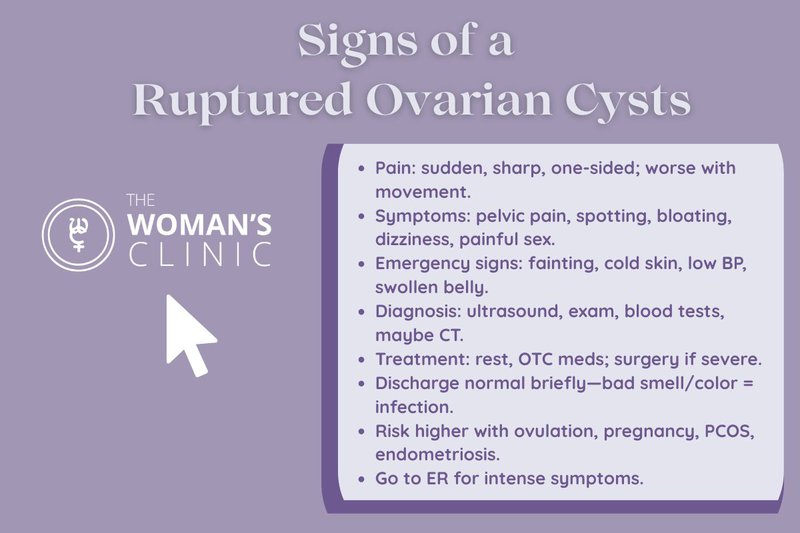If you’ve ever felt sharp pain low in your belly, it could be a sign. A ruptured ovarian cyst can come on fast and hurt a lot. Some women notice bleeding or feel sore afterward. Others feel sick or dizzy. Understanding the signs and symptoms is crucial to knowing when to get checked out and to protecting your ovarian health.
Key Takeaways:
- Ruptured ovarian cyst pain is sudden, sharp, and one-sided, often made worse by movement and eased by rest.
- Common symptoms: pelvic pain, light spotting or discharge, bloating, dizziness, and pain during sex.
- Internal bleeding is serious—watch for fainting, cold skin, low blood pressure, or a swollen belly.
- Diagnosis includes a pelvic ultrasound, physical exam, blood tests, and sometimes a CT scan.
- Most ruptures heal with rest and over-the-counter medicine; surgery is needed only with severe bleeding or infection.
- Discharge is normal for a few days; a bad smell or unusual color could mean infection.
- Rupture risk rises around ovulation, during pregnancy, and with conditions such as PCOS or endometriosis.
- Go to the ER for intense pain, heavy bleeding, fever, or weakness.

Recognizing the Symptoms of a Ruptured Ovarian Cyst
A ruptured ovarian cyst can be painful and sudden. However, by understanding the symptoms, you can respond quickly and confidently. Typically, most people describe the pain as sharp and deep in the lower belly, usually striking one side without warning. Unlike a menstrual cramp, it’s more intense and may feel like pressure or stabbing discomfort, especially as it worsens with movement or coughing.
You might also experience light spotting or bleeding, which is different from your period. This discharge is usually pink or reddish-brown and should not have a foul smell. If it does, or if you notice fever or dizziness, it's time to call your doctor.
Differentiating a Ruptured Ovarian Cyst from Other Conditions
The pain from a ruptured ovarian cyst can be confused with other issues like appendicitis, kidney stones, or even a urinary tract infection. However, cyst rupture pain usually begins suddenly, feels sharp or stabbing, and is low in the abdomen, often on one side.
Other symptoms may include:
- Bloating or abdominal tenderness
- Pain during sex
- Shoulder pain (if internal bleeding irritates the diaphragm)
- Dizziness or fainting
If you’ve experienced pain after intercourse, it might be due to a cyst rupture, especially if it happens more than once. Always report repeated or worsening symptoms to your healthcare provider.
Understanding the Risks of a Ruptured Ovarian Cyst
Most ruptured ovarian cysts are not life-threatening and resolve with rest and monitoring. However, complications can occur when a cyst bleeds heavily into the abdomen or becomes infected.
Watch for Signs of Internal Bleeding:
- Sudden dizziness or fainting
- Low blood pressure
- Swelling or pain that worsens with time
- Cold, clammy skin
These signs may indicate blood loss, which requires immediate medical attention. A fast heartbeat or fever could also signal infection—another reason to act quickly.
In severe cases, a ruptured cyst can affect fertility, especially if an ovary is damaged or removed. While most people have one healthy ovary that continues to function, surgery may be needed if imaging shows significant bleeding or a large cyst.
If left untreated, complications like hemoperitoneum (blood in the abdominal cavity) or sepsis can arise. Visit Johns Hopkins Medicine or womenshealth.gov for more details on rupture complications.
How Doctors Diagnose a Ruptured Ovarian Cyst
Diagnosis begins with a detailed history and physical exam. Your doctor will ask about:
- When the pain started
- Where it’s located
- Whether it’s getting better or worse
The main diagnostic tool is a pelvic ultrasound, which shows whether a cyst has ruptured, shrunk, or spilled fluid into the pelvis. If needed, a CT scan may be used to confirm the rupture and assess internal bleeding.
Your provider may also check:
- Blood pressure and heart rate for signs of blood loss
- A pregnancy test to rule out ectopic pregnancy
- Blood work to assess red blood cell count and infection markers
These diagnostic steps help your doctor decide whether you need rest, medication, or more advanced care.
What Recovery from a Ruptured Ovarian Cyst Looks Like
Recovery from a ruptured ovarian cyst usually takes a few days to a week. Pain often improves within 2–5 days as the body reabsorbs the fluid or blood that spilled during the rupture.
Common Post-Rupture Symptoms:
- Soreness in the lower belly
- Bloating or mild fatigue
- Light spotting or discharge
- Sensitivity near the rupture site
By the second week, most people generally feel back to normal. However, if the pain lingers or worsens, or if you develop a fever, foul-smelling discharge, or dizziness, it's crucial to contact your doctor promptly.
Avoid strenuous activity, sex, or heavy lifting until your provider clears you. Light walking and hydration can also support your healing.
Treatment Options for a Ruptured Ovarian Cyst
Treatment depends on your symptoms and overall health. If you’re stable and not bleeding heavily, home care is usually enough.
Home and Non-Surgical Options:
- Rest and avoid intense movement
- Use a heating pad on your lower abdomen
- Take ibuprofen or naproxen (with your doctor’s guidance)
- Stay hydrated
- Track your symptoms daily
If symptoms worsen or bleeding increases, your doctor may recommend imaging or hospitalization.
When Surgery Is Needed:
Surgery is rare but may be required if:
- There’s significant blood loss
- The ovary is twisted (ovarian torsion)
- Signs of infection appear
- The cyst is abnormally large or complex
Surgical options include laparoscopy (minimally invasive) or laparotomy (open surgery), depending on the extent of internal bleeding. Your care team will aim to preserve the ovary whenever possible.
Managing Pain from a Ruptured Ovarian Cyst
Pain management is a key part of recovering from a ruptured ovarian cyst. Most people respond well to over-the-counter medications, but always talk to your doctor before taking anything new.
Best Pain Relief Options:
- NSAIDs like ibuprofen or naproxen
- Heating pads or warm baths for muscle relaxation
- Herbal teas like chamomile or ginger for added comfort
- Loose clothing and supportive resting positions
Avoid lifting, intense workouts, or sex until your provider approves. For more tips, explore The Woman’s Clinic for clinical guidance.
When to Go to the ER for a Ruptured Ovarian Cyst
Some symptoms require immediate attention. Don’t wait if you feel:
- Sharp, one-sided abdominal pain
- Faint or dizzy
- Short of breath
- Fever or chills
- Heavy vaginal bleeding
Call 911 or go to the ER if you’re unable to stand or feel like you might pass out. Urgent care clinics often can’t do imaging or manage internal bleeding, so the emergency room is the best place for evaluation.
What to Expect from Discharge After a Ruptured Ovarian Cyst
Discharge is common after a ruptured ovarian cyst and usually appears as follows:
- Firstly, pink, brown, or rusty-colored spotting
- Additionally, a light flow lasting a few days
- Importantly, there should be no strong odor or clots
However, if the discharge smells bad or turns yellow or green, it could signal an infection.. Also, if spotting continues beyond one week, check in with your healthcare provider.
Recurring Ruptured Cysts
Ruptured cysts can recur, especially if you have conditions like PCOS (polycystic ovary syndrome), endometriosis, or are taking fertility medications.
Additionally, risk factors may include:
- Ovulatory cycles
- High-impact exercise
- Sexual activity
- Hormonal imbalances
To reduce your risk:
- Track your cycles
- Ask your doctor about birth control, which prevents ovulation
- Schedule regular pelvic exams
If you've had multiple cyst ruptures, your provider may also recommend regular imaging or hormonal therapy to prevent recurrence.
Ruptured Ovarian Cysts During Ovulation or Pregnancy
Cysts often form during ovulation, and sometimes they burst, causing sharp, one-sided pain mid-cycle. This is common and usually mild.
During pregnancy, corpus luteum cysts may rupture in the first trimester. These help produce early pregnancy hormones but can cause pain if they grow too large or burst.
If you're pregnant and suddenly feel sharp abdominal pain or notice spotting, then it's important to call your OB/GYN. An ultrasound cannot only help determine whether a cyst has ruptured, but also assess whether treatment is needed. Fortunately, most cases resolve without harming the pregnancy.
A Ruptured Ovarian Cyst and Period Delays
Hormonal shifts after a rupture can delay ovulation or menstruation. Stress, discomfort, or mild bleeding may also affect your cycle.
Let your provider know if:
- Your period is more than a week late
- You have irregular spotting
- You're unsure if you're pregnant
A pregnancy test and follow-up ultrasound can help clarify the cause.
Take the Next Step Toward Relief and Recovery
If you think you’ve experienced a ruptured ovarian cyst, or if you’re unsure about ongoing pelvic pain and spotting, our team at The Woman’s Clinic in Little Rock is here to help. We provide gentle, expert care and advanced ultrasound diagnostics to guide your recovery. Whether you need pain relief, monitoring, or treatment options, we’ll walk with you every step of the way. Don’t wait—reach out today for answers and peace of mind.

